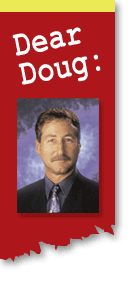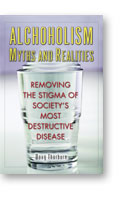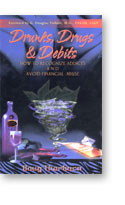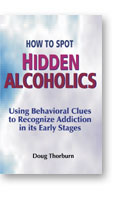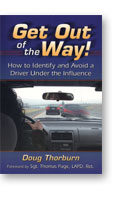|

An Addict's Rage--Mass Murderer Cho
Until recently I often said, "Not every mass murderer in U.S. history has been an alcohol or other-drug addict. For example, Oklahoma City bomber Timothy McVeigh may not have been one. On the other hand, I wouldn't be shocked. By far the vast majority, no doubt, have been addicts."
I was wrong. An astute reader passed along a link with brief biographies of the three main perpetrators of the bombing, which disavowed me of the notion that McVeigh was the exception to the rule. Most interesting is that the biography of McVeigh includes no mention of drug use--more evidence that biographers lack an understanding of the importance of addiction in explaining the behavior of their subjects. Instead, the fifth paragraph in the biography of Michael Fortier, who was aware of the plot and turned state's witness, mentions that "Fortier, a heavy drug user, introduced McVeigh to marijuana and crystal meth." The prosecutor in McVeigh's trial didn't ask about drug use until 3/4ths of the way into the trial testimony, which runs over 71 pages when pasted into a Word document (page 56 for anyone inclined to cut and paste).
Bizarre behaviors, "barely concealed" anger, incoherent statements, rambling writings, blaming others for problems, false accusations, anti-social classroom behavior, violence and the singular statement, "You made me do this!" are each in themselves superb behavioral indications of alcohol or other-drug addiction. A compelling case for addiction can be made when all of these are found in one individual who happens to be on numerous prescription medicines. Yet, not one pundit, talk show host or caller-in to such shows I heard suggested the possibility that the root cause of mass murderer Cho Seung-Hui's anger might be drug addiction. Instead one talking head after another said he was "mentally ill."
Mental illness in itself usually is not an adequate explanation as the primary cause of tragedy. In arguably most cases something goes haywire in the brain that sets off what appears to be a mental illness, or triggers one. When practicing addicts are given the psychological test known as the MMPI, they usually score high on the sociopathic deviancy scale or can be diagnosed as having another Personality Disorder such as Narcissism. After only a few months of sobriety few of those formerly identified as having a Disorder can be so pegged, proving that most such Disorders are manifestations of an underlying psychotropic drug addiction. (You'll find a lot more on this and related topics in my books, especially Chapter 5 of Drunks, Drugs & Debits under the heading "Addiction and therapists," and Myth # 64: "Personality Disorders are more common than alcoholism" in Alcoholism Myths and Realities.)
Some of the behavioral indications of problems-to-come in the case of Cho are now legend, including those cited above. But a few would have been more troubling to the addiction-aware than to others. His writings were so twisted and filled with profanities and macabre violence that they horrified other students. It's no coincidence that many of the greatest horror writers, including Edgar Alan Poe and Stephen King, were alcoholics (with King reportedly in recovery). Who other than an addict could drum up a Jack Torrance (played by Jack Nicholson) in The Shining? And Cho reportedly never removed his sunglasses, even indoors. What drug or drugs might we have identified based on pupil size? Unfortunately, Virginia Tech has so far remained silent on what medicines Cho may have been prescribed due to "privacy" concerns, which is incredible considering he is a mass murderer and dead.
The New York Times reported that prescription medicines were found among Cho's effects, in particular anti-depressants, which contrary to some are unlikely to impel violent behavior by themselves. The odds are there were other drugs on board, even if alcohol was not among them. (Unfortunately because the Virginia Office of the State Medical Examiner will not release the toxicology report or autopsy results we may never have proof one way or the other.) Bob Unruh's article entitled, "Are meds to blame for Cho's rampage?" [click here], is typical in suggesting that anti-depressants cause some people to commit mass murder, listing a plethora of school shootings in which the perpetrator was on one or more of these drugs, including Luvox and Prozac (SSRI's, or Selective Serotonin Reuptake Inhibitors, a class that also includes Paxil and Zoloft). However, while it's possible that anti-depressants in some act as psychotropics (and far more likely that they may trigger violent rage when used in conjunction with other drugs), he misses the boat in omitting the fact that of 20 school shooters listed, at least eight were heavy alcohol users (i.e., alcoholics--and not mentioned by him) or on Xanax or Valium (alcohol in pill form for the alcoholic). He mentions that another three were on Ritalin, a form of speed used by many addicts including actress Judy Garland, as if it were just another anti-depressant. A 12th was described as being on "a variety of prescriptions" and at least seven more were easily old enough to be using alcohol.
Unruh completely ignores alcohol as a precipitator of violence in several very obvious cases. He writes, "Kip Kinkel, a 15-year-old of Springfield, Ore., in 1998 murdered his parents and proceeded to his high school where he went on a rampage killing two students and wounding 22 others. Kinkel had been prescribed both Prozac and Ritalin." However, among Kinkel's ramblings, we find a tell-all passage unmentioned by Unruh: "Today of all days, I ask her to help me. I was shot down. I feel like my heart has been ripped open and ripped apart. Right now, I'm drunk, so I don't know what the hell is happening to me." Bear in mind that due to potentiation, a small dose of any of two or more psychotropic drugs, including Ritalin and alcohol, is all that's needed for one heck of a high.
In citing Eric Harris and Dylan Klebold, responsible for the Columbine school massacre in Littleton, Colorado in 1999, Unruh writes, "Harris had been taking Luvox," as if that might be the sole cause of the tragedy that followed. He failed to mention that Harris had also been consuming plenty of liquor and that his favorite drugs were vodka and whiskey. Unruh follows up his list of 20 school-related killings with nine more gruesome examples of murderers, including Dr. Deborah Green who in 1995 set her home on fire, killing her two young children while on "four medications including Prozac." Unruh ignores Dr. Green's own court testimony of heavy alcohol use that helped “set the stage for this tragedy." He also implies that Prozac impelled Kurt Danysh,18, to murder his father in commenting that the murder occurred just "17 days after his first dose." He overlooked a psychiatrist's testimony that Danysh "had a history of drug abuse" and had admitted to using marijuana, cocaine and hallucinogens.
I don't mean to pick on Bob Unruh. He is, however, a typical example of a reporter who seemingly hasn't a glimmer of understanding of the importance of the drug alcohol or its real look-alikes (not the anti-depressants) in explaining mass murder. Since 80-90% of convicts are alcohol or other-drug addicts and it's so darned difficult to obtain actual evidence of use even on the Internet, the idea that only 11 of 20 mass murderers were such addicts stretches credulity. If journalists understood the role of alcoholism in such stories, they would look for it--and report it in the 1st paragraph rather than the 27th, if at all. If we don't suspect alcohol or other-drug addiction, we never find it. Suspicion in the case of mass murderers is essential if we are to understand the root cause of such tragic acts. And understanding the cause is half the solution.
Postcript: I have previously (September-October 2006 and August 2005) argued the likelihood that suicide bombers--mass murderers of a different stripe--are high on a cocktail of drugs. This includes an amphetamine-tranquilizer combo given to children as young as seven in Sierra Leone's civil war to turn them into little killing machines. Hitler used amphetamines and barbiturates. Uppers and downers, especially in combination, can really mess up a brain.
Runners-up for top story of the month:
"Girls Gone Wild" founder Joe Francis, 34, indicted on two counts of tax evasion following his arrest on a contempt-of-court citation stemming from a civil case in Florida, where he is being held. The tax charge alleges he deducted more than $20 million in false business expenses on corporate returns in 2002 and 2003, including $3.78 million for building a residence in Punta Mita, Mexico (the northernmost point in the Bahia de Banderas, where Puerto Vallarta lies). The federal grand jury indictment also alleges he used offshore bank accounts to conceal income. His attorney, Jan L. Handzlik, said the indictment was unwarranted and should be, at most, a civil dispute.
The question a Drug Addiction Recognition Expert(TM) can help answer is, what might Joe Francis be capable of? If he is tentatively identified as having the disease of alcoholism, the DARE knows he is capable of anything, including tax fraud, and is far more likely (by roughly a ten to one ratio) to commit such crimes than a non-addict. Francis, it turns out, is not a non-addicted Hugh Hefner wannabe. He screamed expletive after expletive at a Los Angeles Times reporter who asked him about an incident in which he was accused of non-consensual sex. He also falsely accused the reporter of having a crush on him and an ax to grind because she was "jealous and angry."
The reporter, Claire Hoffman, found she wasn't the only woman at whom Francis has spewed venom. Reportedly upset about the noise garbage collectors made in the morning, a time during which some alcoholics are sleeping off the previous night's partying and the BAL is in decline (which is tough on the body and brain), Francis allegedly harassed and threatened the property manager of his Santa Monica apartment, Stephanie Van de Motter. Sober people are unlikely to (allegedly) climb up to someone else's bedroom window on two separate occasions, pound violently on the glass and scream obscenities. Another time, a scout for locations who arranged for a Halloween party space rental was subjected to threats and profanities when she refused to return his $25,000 deposit because the 2,000 guests had trashed the place.
Francis has been accused of habitually supplying alcohol to underage girls and appeared as if he might be under the influence on a Howard Stern show interview. He has repeatedly been charged with criminal conduct and has been the plaintiff in several lawsuits, either of which by itself strongly supports a diagnosis of alcoholism. Recently, he was charged with possession of a controlled substance and, while in jail, allegedly found with drugs, including lorazepam (in the same class as Valium, alcohol in pill form for the alcoholic) in his cell. The Drug Addiction Recognition Expert(TM) would conclude that Joe Francis's misbehaviors are best explained--not excused--by the disease of alcoholism and that he is, therefore, capable of anything--including behaviors that suggest he thinks he is more powerful than the taxing arm of the U.S. government.
Rapper-actor Snoop Dogg, whose real name is Calvin Broadus, quickly pleading no contest to two felony charges, transportation of a controlled substance and gun possession by a convicted felon, in exchange for avoiding jail. He received a three-year suspended sentence, five years' probation and will be required to complete 800 hours of community service. He was convicted in 1990 of felony drug possession and intent to distribute and in February 1996 was acquitted of murder charges in an August 1993 shooting death.
Rolling Stones guitarist Keith Richards, 63, in a classic example of addicts doing crazy things, admitting that he mixed his father's ashes with cocaine and snorted it. It's hard to say which is crazier—doing it, or admitting to having done it.
Jimmy Lee Smith, whose March, 1963 high-profile killing of LAPD officer Ian Campbell was chronicled by Joseph Wambaugh in his 1973 book, The Onion Field, dead of a heart attack at age 76. Smith, whose story is a classic in the annals of a perennial relapsing recidivist, ran away from home at 16 and was arrested for burglary and narcotics possession in 1950. He was arrested again for burglary two years later, paroled, arrested in 1959 and paroled just weeks before Officer Campbell's murder. His death sentence was reduced to life in prison after the California Supreme Court outlawed the death penalty; despite public outrage, he was paroled in 1982. Four months later he failed a drug test and got a return ticket to prison. (For God's sake, if we're going to parole murderers, let's not give second chances.) After serving six months, he was paroled again and then rearrested on trafficking charges. He was released in 1986 and rearrested in 1987 for DUI. After being paroled yet again, he was arrested in 1989 for terrorizing a woman he held captive over a weekend in West Covina, California. In 1990, out of prison--again--he was arrested in Van Nuys, California for threatening a man with a knife. The pattern continued until February, 2007 when Los Angeles police found him living on skid row and violating parole. He died in the Pitchess Detention Center in Castaic, north of Los Angeles.
Under watch:
Actor Alec Baldwin, whose divorce from actress Kim Basinger reads like "War of the Roses," leaving an angry phone message for his 12- er, 11-year old daughter Ireland. Both Baldwin and Basinger have been on my radar for years. I learned long ago that the addict in a familial relationship can easily be misidentified and that in the case of Baldwin v. Basinger, we really can't know if it's him, her or both. However, as recovering alcoholics readily admit, the movie "War of the Roses" starring Michael Douglas and Kathleen Turner was a story requiring alcohol or other-drug addiction in either or both. So it likely is with Baldwin/Basinger.
Durham, North Carolina District Attorney Mike Nifong, roundly condemned by North Carolina Attorney General Roy Cooper for rushing to accuse and failing to verify allegations of rape of a 28-year-old black stripper by three young Duke University lacrosse players, highlighted in the April-May 2006 issue of the Thorburn Addiction Report. Cooper called Nifong a "rogue" and "overreaching" prosecutor and, to his great credit, said flat out that the three players were innocent. Nifong faces ethics charges for withholding DNA evidence showing that several unidentified males and not the accused were the sources of genetic material found on the accuser. Cooper has not ruled out filing criminal charges against Nifong after the ethics charges are resolved, but decided against filing such charges against the accuser because he concluded "she may actually believe the many different stories she has been telling." There's no question about the accuser having the disease of addiction. There is also no question that Mike Nifong, having stuck by a false accusation in a bid to increase his power (he won an election because he won the black vote due to his support for the accuser's story) that could have resulted in 30 years imprisonment for each of three innocent men, exhibited as destructive a behavioral clue to alcoholism as exists short of murder.
Adelanto, California mayor Jim Nehmens, 50, and his wife, Kelly, 44, charged with grand theft by embezzlement. Nehmans was president of the Adelanto Little League for the last nine years and allegedly stole more than $20,000 from 2004 to 2006, mostly from the sale of fireworks intended to supplement the Little League's income. He was reelected mayor of the small but fast-growing San Bernardino town in 2006 after first being elected to the city council in 2000, the year he and his wife filed for Chapter 7 bankruptcy, and then mayor in 2004. Mr. and Mrs. Nehmens, since it would be defamatory to suggest you could be so callous as to declare bankruptcy while running for elected office and then (allegedly) steal from children while sober, we hope either or both of you have the disease of alcoholism and that you seek appropriate help.
Co-Dependents of the Month:
A "codependent" is someone who is or has been in a committed relationship with an alcohol or other-drug addict, or has been severely and negatively affected by one. Director Bob Clark, 67, best known for "Porky" and the holiday classic, "A Christmas Story," and his son, Ariel Hanrath-Clark, 22, unfortunately became such codependents for the instant before they both died in a head-on crash. Hector Velazquez-Nava, 24, was arrested for DUI and gross vehicular manslaughter after driving his 2007 GMC Yukon north in the southbound lanes of Pacific Coast Highway into the Clark's 1997 Infiniti Q30 at 2:30 in the morning. There were no doubt dozens--or hundreds--of incidents for which friends, family or the law could have intervened in Velazquez-Nava's alcoholism, but didn't. His blood alcohol level was .24 per cent and he walked away from the accident with minor injuries.
Enabler of the Month:
Playboy Magazine, which featured Anna Nicole Smith as the May 2007 cover story, continuing the sort of enabling that resulted in her untimely demise. To their credit, she was described from the start as being "moody, very needy, expecting first-class treatment all the time." According to Playboy's former Director of Public Relations, Elizabeth Norris, the magazine didn't do a publicity tour for her first pictorial because she sounded "silly." Smith, in classic alcoholic fashion, was described as resentful for not getting to do the tour. The story also suggested the need to walk on eggshells when dealing with her (she was "furious" when the centerfold story made her sound like a glutton). Either of these behaviors would have been, to the addiction aware, initial indications of possible early-stage alcoholism. While reversing cause and effect ("here's someone who wasn't educated or sophisticated--how could she handle [all that fame]?"), the piece reported she was on prescription drugs early on and that she needed "a glass of wine to loosen up" early in the day, even asking for a second bottle of champagne while on prescription drugs. Examples of her drinking early on included downing a bottle of Cristal Champagne while her makeup artist got her ready and demanding a bottle of Jack Daniel's while shooting a pictorial. The piece also noted that "her ego grew" and her behaviors became more mercurial over a relatively short period of time. Unfortunately, many young addicts will follow in her footsteps just as she did in Marilyn Monroe's because of the glorification that Hugh Hefner himself did best to perpetuate: "Anna Nicole was one of the greats. And as long as we have her photos, she will not be forgotten...There's a sort of immortality in the images she left behind."
Dr. Khristine Eroshevich, a Los Angeles psychiatrist and "friend" of Anna Nicole Smith, under investigation for authorizing all 11 prescription medications--none in Smith's name, with eight in her friend Howard K. Stern's name--found in Smith's hotel the day she died. More than 600 pills were missing from prescriptions that were less than five weeks old, including 303 chloral hydrate tablets prescribed five weeks before she died (averaging about nine per day) and 62 Valiums prescribed two weeks before she died (averaging over four per day). Both drugs are powerful sedative-hypnotics. The other drugs included a couple of anti-anxiety medications, three muscle relaxants, a migraine med, a diuretic and an antibiotic. The California Medical Board is also investigating another physician, Dr. Sandeep Kapoor, after reports surfaced that he may have prescribed methadone to Smith under an alias, which found its way to her son, Daniel Smith, and contributed to his death in 2006.
Note to family, friends and fans of the above: the benefit of the doubt is given by assuming alcoholism (they are either idiots and fundamentally rotten, or they are alcoholic/other drug addicts--which would explain the misbehaviors). If alcoholic, there is zero chance that behaviors, in the long run, will improve without sobriety. An essential prerequisite to sobriety is the cessation of enabling, allowing pain and crises to build. Thus far, many have done everything they can to protect the addict from the requisite pain, making these news events possible. The cure for alcoholism, consequential bad behaviors and, ultimately, tragedy, is simple: stop protecting the addict from the logical consequences of misbehaviors and proactively intervene.
|





 Release the Records
Release the Records